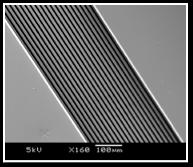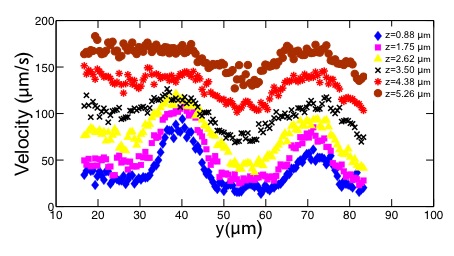Slippage in microfluidics
Slippage phenomenon in microfluidics is experimentally investigated for a pressure-driven flow in a variety of micro- and nano- structured hydrophobic microchannels (see the figure as an example). The channels are chemically hydrophobic and microscopically patterned. The combination of surface roughness and water repellency can promote gas layers upon the hydrophobic walls, thereby providing shear-free boundary conditions and enhancing the flow velocities. The microflow velocities are obtained with micro-particle image velocimetry. The flow fields are used to study the slippage and the effective boundary condition.


Figure 1: An example of used micropatterned hydrophobic polymeric surface (left), and the velocity profiles at different channel heights z away from the hydrophobic wall obtained by micro-particle image velocimetry (right). High velocities take place above the shear-free air-liquid interfaces right above the microgrooves, whereas the small velocities occur right above the liquid-solid interfaces.
Info: Detlef Lohse
Researchers: Amy Tsai, Alvaro Marin, Detlef Lohse.
Collaborators: Membrane Science and Technology Group at U Twente, and BIOS group at U Twente.
Embedding: IMPACT
